2020 Spring Symposium: Save the Date
February 15, 2020 in Announcements, Conference, Conference Announcement, Events, Index of Medieval Art, Princeton University, Reception, Uncategorized
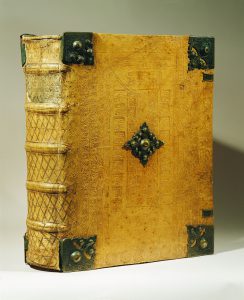
New York, Grolier Club, *434.14Aug1470Folio.
“From Cover to Cover”
Activities Devoted to Manuscripts, Early Printed Books & Beyond
From Collecting & Cataloguing to Deciphering & Beholding
2020 Spring Symposium
of the Research Group on Manuscript Evidence
Princeton University
Friday & Saturday 13–14 March 2020
Update 5 April 2020
The Symposium Booklet, with illustrations and Abstracts of Papers, is now published and available for download.
See Keeping Up: Updates for Spring 2020.
The Abstract of one paper in the 2020 Symposium Booklet has been expanded to a Draft Paper, available for Feedback:
- “A Quick Introduction to Indian Manuscripts for the Non-Specialist”, with examples and illustrations,
downloadable here.
Update 9 March 2020
This event is now cancelled, as Princeton University and other institutions respond to current health concerns, and take precautions regarding travel and meetings of various kinds in person.
The Symposium might be rescheduled, conditions permitting.
Meanwhile, the Research Group aims to complete the Symposium Booklet and distribute it to contributors, registrants, and others, as a souvenir of our speakers’ good intentions. Already, as a sign of appreciation, we have adopted the custom of posting on our website the abstracts of contributors who become unable to attend to present in person (as with the 2018 Congress, among others).
This time, under wider — even global — circumstances affecting the ensemble as a whole, we wish to show appreciation for the remarkable enthusiasm and dedication for the collaborative event demonstrated by our hosts, sponsors, speakers, moderators, and others. This knowledge is something to remember with satisfaction, gratitude, and praise.
The publication could, perhaps, give a token to show for our shared efforts, and to demonstrate something of the spirit of dedication and focus which prepared to assemble for the event itself.
This aim might help to ease some of the disappointment over cancellation, while the cancellation itself might ease some uncertainties about travel at present.
P. S. Only once before, in more than 30 years of activities in many centers in the United States and elsewhere (see our Events and Congress Activities}, has the Research Group had to cancel an event. It, however, was only 1 Session among 7 sponsored and co-sponsored Sessions at the 48th International Congress on Medieval Studies in May 2013, when the Session organizer and 2 presenters were unable to travel to the Congress. We honored their intentions to contribute by continuing to record their abstracts and the statement of purpose of the Session on this website.
Similar solidarity pertains to our record of this intended 2020 Spring Symposium. A summary of this Update appears in its own post.
Here we preserve the description of the event in the updated version just before the decision to cancel this Symposium, among many gatherings at Princeton University and elsewhere at the beginning of the week in which the Symposium was planned to take place.
*****
What We Planned
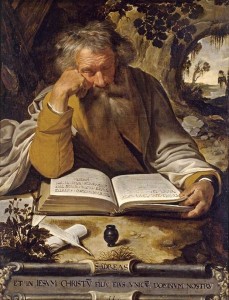
Saint Andrew. Oil on Canvas. Artus Wollfort (1581–1641). Private Collection, Public Domain. Via Wikipedia Commons.
We announce the next Symposium of the Research Group on Manuscript Evidence, to be held at Princeton University on Friday afternoon and Saturday, 13–14 March 2020. This event follows from, and builds upon, our earlier events, including our 2019 Anniversary Symposium, also held at Princeton University.
Our subject this time: “From Cover to Cover”. Some say, “That Covers It”. (We might well agree.)
Such activities include Collecting, Curating, Conserving, Cataloguing, Deciphering, Editing, Reading, Teaching, Translating, Displaying, Accessing, Beholding, Reconsidering, and More. Cover to Cover.
Naturally, these activities need not necessarily occur in that order, and often they appear in combination.
In addition we consider activities dedicated to manuscripts, early printed books, and beyond, in terms (as is our custom) of both media and chronology. As often, we consider medieval manuscripts and early printed books from Western Europe, but also— as usual — we examine materials from other cultures, languages, and time-frames.
This recognition of the processes (necessarily integrated) infuses the collection of presentations and conversations which our Symposium aims to gather. In a nutshell: Food for Thought, Refreshments included.
For which ability, we have Sponsors, Hosts, Trustees, Associates, Contributors, and Volunteers heartily to thank.
Sponsors
Research Group on Manuscript Evidence
Department of Art & Archaeology, Princeton University
The Index of Medieval Art at Princeton University
Program in Medieval Studies, Princeton University
James Marrow and Emily Rose
Barbara A. Shailor
Celia Chazelle
The Schoenberg Institute for Manuscript Studies
The Bibliographical Society of America
On the Road
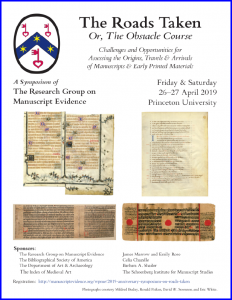
Poster 1 for 2019 Symposium
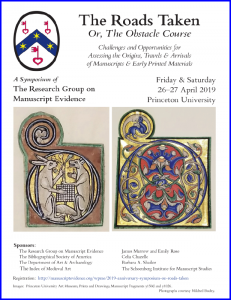
Poster 2 for 2019 Symposium
Following upon, and building upon, the success of our Anniversary Symposium last year, we prepare the 2020 Spring Symposium. Its date is now set, as is the Schedule. (See below.)
For our 2019 Anniversary Symposium, see its Report and its freely downloadable 2019 Anniversary Symposium Booklet. Like the Booklet, the 2 Posters (seen here) illustrate examples of manuscripts (Western and non-Western) showcased in the Symposium, its papers, and its workshops.
All these publications, as customary, are set in our very own copyright multilingual font Bembino , and designed and laid out according with our Style Manifesto. This font is freely available through our website, for your use – whether individual, nonprofit, or commercial.
Both the font, and its descriptive Booklet, are downloadable here . We have also prepared a booklet showing its abilities in setting multiple languages, both Western and non-Western. See Multi-Lingual Bembino . Plus our Style Manifesto .
Cover Story
Now we turn to our 2020 Spring Symposium. Please register (details below).

Poster 1 for the 2022 Spring Symposium.
Gladly we list the Sponsors, Speakers, and Moderators.
Speakers and Moderators (in alphabetical order)

Philadelphia, University of Pennsylvania Libraries, Lawrence J. Schoenberg Collection, MS LJS 101, folio 1v. Photograph courtesy OPenn.

Paris, Bibliothèque nationale de France, MS latin 190, folio 1r. Photograph via gallica.bnf.fr.
Christine E. Bachman (Art History Department, University of Delaware and Graduate Student Fellow 2019–2020, Schoenberg Institute for Manuscript Studies, University of Pennsylvania)
Mildred Budny (Director, Research Group on Manuscript Evidence, Princeton)
Raymond Clemens (Curator, Early Books and Manuscripts, Beinecke Rare Book and Manuscript Library, Yale University, New Haven)
Meghan Constantinou (Librarian, The Grolier Club, New York, New York)
Barbara Williams Ellertson (Books as Symbols in Renaissance Art and Research Group on Manuscript Evidence)
Lynley Anne Herbert (Curator of Manuscripts and Rare Books, The Walters Art Museum, Baltimore, Maryland)
Carson Koepke (Program in Medieval Studies, Yale University)
Laura Light (Director and Senior Specialist, Text Manuscripts, Les Enluminures)
John T. McQuillen (Associate Curator, Printed Books & Bindings, The Morgan Library & Museum, New York, New York)
Bernard Maisner (Bernard Maisner and Bernard Maisner, Master Calligrapher)
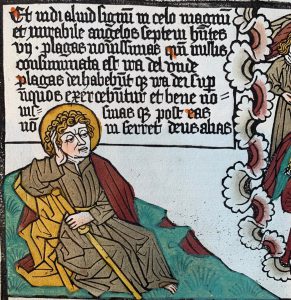
New York, Morgan Library & Museum, PML 7, folio P2r. Blockbook of Apocalypsis Sancti Johannis, printed in Germany circa 1468. Revelation 15:1, with hand-colored illustration.
Sabrina Minuzzi (Researcher in Early Modern History, Marie Skłodowska-Curie Fellow, Ca’ Foscari University of Venice)
Ronald D. Patkus (Associate Director of the Libraries for Special Collections and Vassar Head of Special Collections, Vassar College, Poughkeepsie, New York)
Pamela Patton (Director, Index of Medieval Art at Princeton University)
Lynn Ransom (Curator of Programs, The Schoenberg Institute for Manuscript Studies, University of Pennsylvania Libraries)
Helmut Reimitz (Professor of History and Director, Program in Medieval Studies, Princeton University)
Jessica L. Savage (Art History Specialist, Index of Medieval Art)
Barbara A. Shailor (Department of Classics, Yale University, and President, Bibliographical Society of America)
David W. Sorenson (Independent, Quincy, Massachusetts)
Kelly Tuttle (Project Cataloger, Manuscripts of the Muslim World, University of Pennsylvania Libraries)
Eric White (Curator of Rare Books and Acting Curator of Manuscripts, Special Collections, Firestone Library, Princeton University)

Princeton University Library, Rare Books and Special Collections, William H. Scheide Library, 53.8. Latin Bible (printed in Strasbourg by Johann Mentelin, not after 1460 CE.) Photograph courtesy Princeton University Library, Rare Books and Special Collections.
The Aim
In a nutshell.

2020 Spring Symposium Announcement, describing the scope of the event, listing the Sponsors, and citing the link to the registration form.
The Plan
Day 1
Friday 13 March: Classes, Workshops, Discussion, and a Reception
1) 12:00–1:00, 12:00–1:30, or 12:00–2:00pm (By Invitation)
Seminar Room of the Index of Medieval Art
2–3) 1:00–2:45 pm or 3:00–4:45 pm
Classes on Site at Firestone Library (Registration Required and Space Limited)
For registration for these classes and the symposium, see below.
“Material Evidence: A Workshop with 15th-Century Manuscripts and Incunabules”
Classes given (twice) by Eric White, Curator of Rare Books, Princeton University Library, in the Large Classroom of Floor C (Rare Books and Special Collections) at Firestone Library
Please gather in the Lobby at the entrance to Firestone Library, for special escorted access to Floor C, where there are lockable lockers (free) for your coats and cases, before entry to Special Collections.
2) Class 1: Meet at 1:00 for 1:15–2:45 pm
3) Class 2 (repeated): Meet at 3:00 for 3:15–4:45 pm
or
4) Session 3:00–5:00 pm
106 McCormick Hall
“Materials, Processes & Products: A Workshop”
This workshop offers presentations by Bernard Maisner on “The Materials and Methods of Medieval & Renaissance Manuscript Gold-Illumination Techniques” and by David W. Sorenson on “An Introduction to Indian Manuscripts for the Non-Specialist”, along with curated displays of original materials in private collections and demonstrations of results from their close study.
5) Reception
5:00–7:00 pm
Lobby outside 106 McCormick Hall

Florence, Galleria degli Uffizi, Anonymous, Still Life of an Illuminated Book, German school of the XVI century, circa 1510. Opened book with fanned leaves. Image via Wikimedia, public domain.
Day 2
Saturday 14 March: Sessions, Refreshments, and Reception
106 McCormick Hall and its Lobby
6) 10:00 am – 5:30 pm
Sessions, Coffee Breaks, Lunch, and Discussion
7) Reception (5:30–7:00 pm)

2020 Symposium Poster 2
*****
The Schedule
The Schedule is available here.
*****
Registration
Please register for the Symposium. We offer the Registration form as a downloadable pdf .
*****
Maps and Directions
Here.
*****
Please Contact us with questions and suggestions.
Watch this space and visit our FaceBook Page for updates.

Floral Motif as Lower Border in a Book of Hours. Photography Mildred Budny.
We invite you to donate to our nonprofit educational mission. Donations may be tax-deductible. We welcome donations in funds and in kind: Contributions and Donations .
Please join us at the symposium, open to all. You can register here .
*****

Fascinating. Great work is obviously being done. Keep up the good work!
Michael T. Kiesel, Esq.
Thank you for your response!
This is a great article for me personally as I am newbie into this field, Anyway thank you for the post
We appreciate your thanks!
This is a great article for me personally as I am newbie into this field, Anyway thank you for the post..
Very very good article. I really appreciate your article.